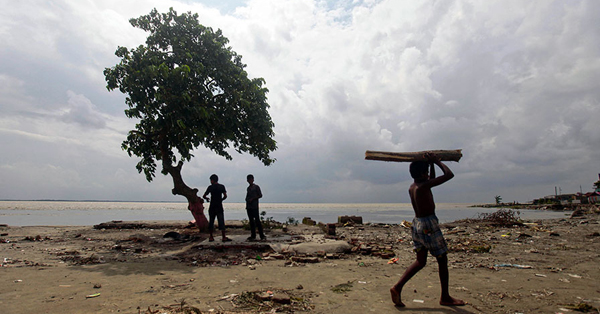Published in Monitor Global Outlook of the Christian Science Monitor, on 25 June 2014.
China embarks on a bridge to India – and high-wage work
ON-THE-GROUND: “China can be our second-biggest single country export destination after the US.” – Abdus Salam Murshedy, Envoy Group
Beijing’s deals with Dhaka including construction of a 3.8 mile bridge in Bangladesh’s southwest is a move towards expanding Chinese market in the region.
For China, the road to greater riches lies across the Padma River in Bangladesh. There, trucks from China charging across Myanmar and through Dhaka are confronted by waters with no fixed bridge crossing. West of the river, Bangladeshi garment factories and the billion-person market of India beckon.
It’s not unusual for China to penetrate markets with the help of big ticket infrastructure. When construction starts in August, the $1.6 billion Padma Multipurpose Bridge will be not so different from the road and rail links Chinese firms have built all over Africa. Except for this: China isn’t making a beeline for raw materials. This time, they are beating a path to low-wage workers and middle-class consumers.
The bridge – along with a number of other infrastructure deals struck between Beijing and Dhaka this month – represent an early sign that China is finding it more economical to leave some basic manufacturing to others while it climbs the value chain.
That’s left a lot of work up for grabs globally, with some of the demand now coming from retailers in China.
Since 2012, brands operating out of China have been importing basic apparels from Bangladesh. The trend is growing quickly, with such imports already totaling $171.77 million in the first nine months of the fiscal year, up from $139 million for all of 2012/13.
French retailer Carrefour has more than 200 stores in China and is among the top international brands fulfilling Chinese clothing orders from Bangladesh since 2013, an official of Carrefour tells Monitor Global Outlook.
The Chinese shift is helping offset negative impacts on demand due to rising wages for Bangladesh’s garment workers. Orders for low-priced basic apparels such as T-shirts and jeans will come to Bangladesh in larger quantities as Chinese clothing suppliers shift toward advanced technologies for manufacturing value-added clothes, says Abdus Salam Murshedy, managing director of Envoy Group, a key supplier of H&M and Carrefour to the West and China.
“China can be our second-biggest single country export destination after the US,” says Mr. Murshedy.
Bilateral trade between China and Bangladesh has reached $6.7 billion in 2013, according to the Export Promotion Bureau of Bangladesh. The amount is more than 10 percent of Bangladesh’s total volume of trade in the year. Bangladesh’s exports to China have surged from $458 million in fiscal year 2012/13 to $677 million between July 2013 and May 2014. (The fiscal year runs July through June.)
Prime Minister Sheikh Hasina’s visit to Beijing this month resulted in a number of other major agreements, including the construction of a 1,320-megawatt coal-fired power plant in southwestern Patuakhali and a specialized economic zone.
In addition, the Bangladesh Garment Manufacturers and Exporters Association (BGMEA) signed a $1.2 billion memorandum of understanding with the Chinese company Orient International (Holding) Co. for developing an industrial park on 470 acres of land the Bangladeshi government allocated for the garment industry.
“The deal comes at the most appropriate time when the [Bangladeshi garment] industry requires relocation [for safety compliance and dedicated infrastructure],” says Murshedy, who also served as a former president of the BGMEA.
A Chinese-built special economic zone and an industrial park exclusively for Bangladesh’s garment industry will encourage larger-scale Chinese investments in Bangladesh’s garment sector.
“Chinese are investing heavily in developing countries. [The recent agreements] have established that we are willing to receive Chinese investment,” says Fahmida Khatun, head of research at the Centre for Policy Dialogue in Dhaka.
China’s heavy investment here isn’t just about Bangladesh, but about its bigger neighbor next door, India. The deal between the Bangladesh government and China Major Bridge Engineering Company (MBEC) for the construction of the 3.8-mile Padma Bridge is the crucial piece of a regional economic corridor – a direct highway between Kunming and Calcutta using roads in Myanmar and Bangladesh.
But more than rivers and mountains have kept China and India from improving on their relatively small $65 billion in bilateral trade. The two Asian giants have viewed each other with suspicion since a border war in 1962. The most important bridges needing to be built are diplomatic ones.
China appears interested, reaching out early and enthusiastically after Narendra Modi swept to power in New Delhi. But Beijing’s investments in Bangladesh – particularly in a proposed seaport – worry India. The port would be the fourth in a neighboring country, another bead in what India sees as a “string of pearls” strategy of encirclement.
Indeed, shipping industry sources tell MGO for a report this week that the port makes more geopolitical than economic sense.
Bangladesh Prime Minister Hasina has done little to dispel India’s concerns. Following her visit to China, she said that the relationship between China and Bangladesh has been elevated to a strategic partnership from an economic one.
Geopolitics aside, the concept of an economic corridor between China and India would bring down transport costs and increase trade across the region. But few details of the corridor have been hammered out. A second study group among the countries involved is set to meet in September in Bangladesh.


